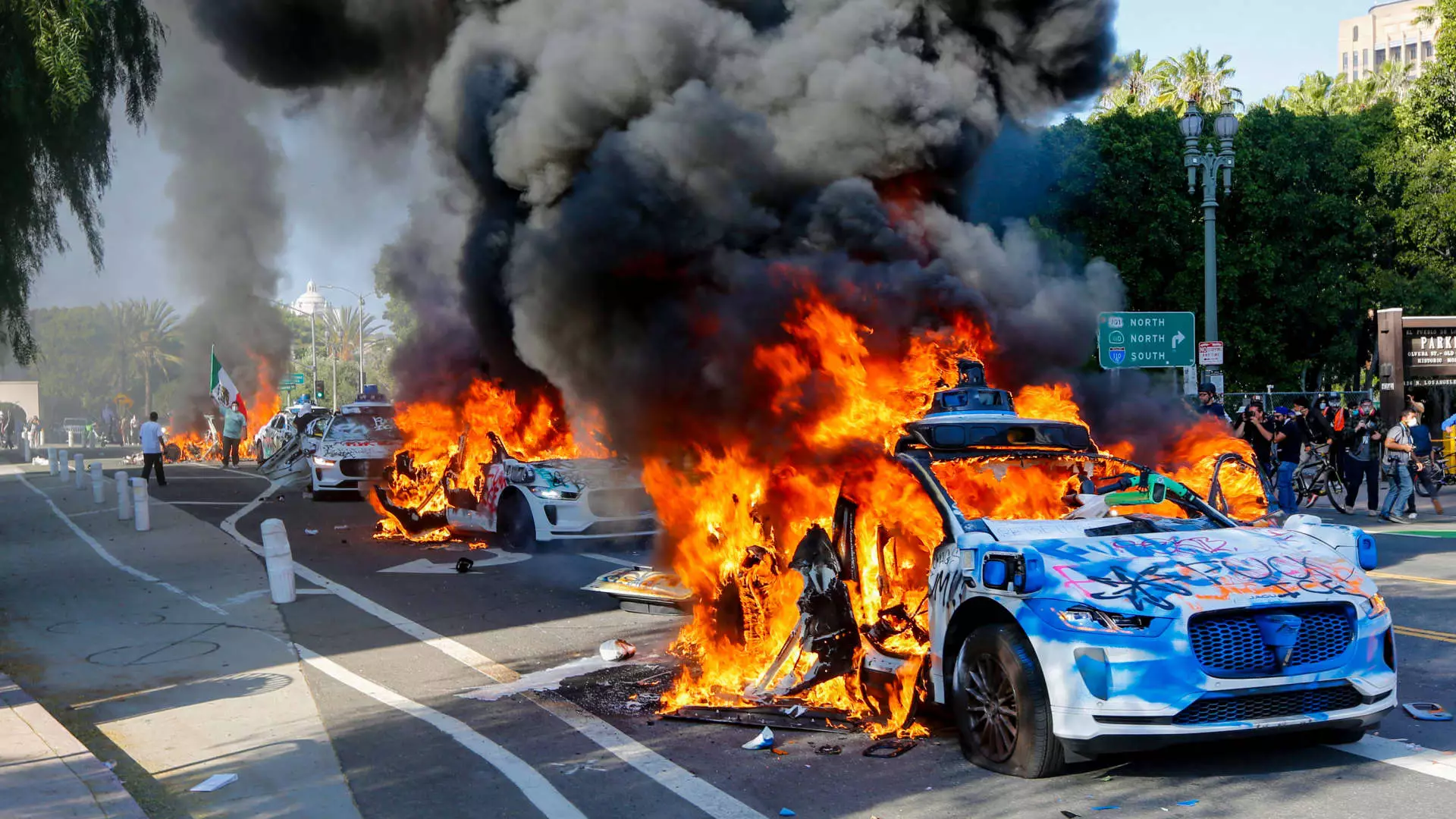In recent days, Los Angeles has been a battleground for democratic expression, with protesters taking to the streets to express their fury against an immigration policy deemed draconian by countless citizens. However, this surge of public dissent morphed into chaos when several Waymo autonomous vehicles found themselves ensnared in the flames of protest. When the line between peaceful demonstration and reckless vandalism blurs, one must ponder the complex intersection of technology and society and whether our innovations can truly withstand the heat of political strife.
The decision to set fire to these self-driving taxis—devoid of human drivers and intentions—poses critical questions about the ethics of collateral damage in protests. Protesters demanding justice and humanity for vulnerable immigrant communities shouldn’t discard the very tools of innovation that many hope will elevate society. When the narrative becomes one of destruction rather than constructive dialogue, the ferocity of passion risks overshadowing the cause itself.
Waymo: A Symbol Made Vulnerable
Waymo’s foray into autonomous driving signifies hope for a future where transportation could be safer and more efficient. Yet, the recent violence against these vehicles unveils a vulnerability not only in the technology but also in the societal lens through which we view progress. The incident raises awareness about how symbols of innovation—like Waymo robotaxis—can quickly fall prey to the tides of frustration and discontent.
While these vehicles represent a pivotal step towards sustainable transportation, they are increasingly viewed as tools of oppression by some, associated with federal enforcement and immigration crackdown. The fiery attack on the Waymo vehicles resonates deeply, blurring the line between a critique of technology and a reaction against the government policies it may inadvertently support. When protesters turned against the robots, were they targeting the symbol of oppression or merely reflecting their frustration with a broader landscape of injustice?
The Consequences of Blind Defiance
In the chaos, there is often little regard for the unseen consequences. The LAPD’s warning regarding the dangers posed by burning lithium-ion batteries speaks volumes about the recklessness displayed during the protests. The act of destruction does not merely convey dissension but also places additional burdens on emergency responders who must address the fallout of these rash actions. Amid the outrage and thirst for justice, it becomes crucial to comprehend the full ramifications of our actions—an insight that seems lost when passion runs high and reason fades into the background.
Moreover, simulating a violent backlash against the status quo undermines the ongoing efforts to create meaningful change. Discontent catalyzed by government actions is valid; however, losing sight of constructive discourse and opting for destruction only serves to harm the very communities that the protests aim to defend. This juxtaposition reveals a paradox of activism: how individuals direct their anger can either illuminate a path toward justice or lead to a cycle of consequence that forces them further from achieving their goals.
The Political Landscape: A Stage for Divided Ideologies
The recent events have also served to accentuate the fissures within our political framework. The response from Governor Gavin Newsom and President Trump’s escalating rhetoric reveals a divided partisan landscape, with each side positioning itself against the other instead of seeking a nuanced discussion. Trump’s aggressive suggestion to target Newsom highlights a willingness to escalate conflict rather than negotiate solutions, while Newsom’s commitment to resisting federal overreach underscores a vital stance for state rights amid federal aggression.
As tensions rise and communities fracture, a vital question emerges: how do we build bridges instead of walls? While the protests echo the demands for immigration reform that resonate deeply within California’s diverse fabric, the actions undertaken in the heat of passion may leave lasting scars on social cohesion. Striking a balance between necessary dissent and responsible activism may prove to be one of the most crucial challenges of our time.
In a landscape where technological advancement and social justice are increasingly intertwined, realizing that progress can only be sustained through collaboration rather than confrontation is imperative. Amid the raging flames that engulfed Waymo vehicles, we must protect the hope they represent—one that could someday lead to a brighter, more inclusive tomorrow.

Leave a Reply